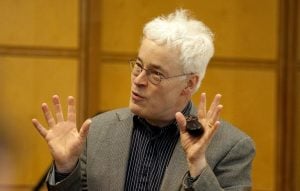
Nick Trefethen, professor of numerical analysis at Oxford University and Global Distinguished Professor at New York University, will deliver the fourth-annual Kliakhandler Public Lecture at 5 p.m. Thursday, Oct. 4, in Dow 641. The title of his lecture is “The Mathematics of the Faraday Cage.”
Trefethen has received many honors for his research in Numerical Analysis: Fellow of the Royal Society, Member of the National Academy of Engineering, the Gold Medal from the Institute for Mathematics and its Applications (UK), the Naylor Prize from the London Mathematical Society, etc. He is also past-president of the Society for Industrial and Applied Mathematics. His previous lecture at Michigan Tech, “Discrete or Continuous”, has the distinction of being perhaps the only standing-room-only mathematics lecture ever given at the University.
Trefethen describes his talk as follows: “Everybody has heard of the Faraday cage effect, in which a wire mesh does a good job of blocking electric fields and electromagnetic waves. Surely the mathematics of such a famous and useful phenomenon has been long ago worked out and written up in the textbooks? It seems to be not so, and indeed, one of the few treatments to be found in the textbooks, by Feynman, is incorrect. The shielding effect turns out to be not as simple as one might expect: it depends on the wires having finite radius. Nor is it as strong as one might imagine: it improves only linearly as the wire spacing decreases. This talk will explain how the Faraday cage works and tell the story of the surprises Jon Chapman, Dave Hewett and I encountered along the way.”
Everyone is invited.
Trefethen will also deliver a research colloquium to the Department of Mathematical Sciences at 4:05 p.m. Friday, Oct. 5, in Fisher 138. The presentation is titled “Random functions, random ODEs, and Chebfun.”
What is a random function? What is noise? The standard answers are nonsmooth, defined pointwise via the Wiener process and Brownian motion. In the Chebfun project, we have found it more natural to work with smooth random functions defined by finite Fourier series with random coefficients. There are plenty of conceptual challenges in this subject, starting with the fact that white noise has infinite amplitude and infinite energy, a paradox that goes back in two different ways to Einstein in 1905.